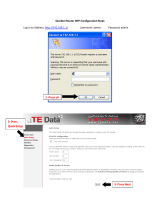
PrimaryNetwork ..........................................................................................................................................49
GuestNetwork..............................................................................................................................................53
Advanced ......................................................................................................................................................58
WPS ..............................................................................................................................................................60
Bridging ........................................................................................................................................................62
AccessControl ..............................................................................................................................................63
WMM(Wi‐FiMultimedia) ............................................................................................................................66
NeighborAPs ................................................................................................................................................68
CHAPTER 9 BASIC MENU OPTIONS.............................................................70
BasicLANSet tings ........................................................................................................................................70
DHCP.............................................................................................................................................................72
WANSettings................................................................................................................................................73
MyNetwork..................................................................................................................................................75
CHAPTER 10 ADVANCED MENU OPTIONS.................................................. 77
MACFiltering................................................................................................................................................77
IPFiltering ....................................................................................................................................................79
PortFiltering.................................................................................................................................................81
PortForwarding............................................................................................................................................83
PortTriggers..................................................................................................................................................85
DMZHost......................................................................................................................................................87
DDNS ............................................................................................................................................................89
RIPSetup ......................................................................................................................................................91
Options .........................................................................................................................................................93
CHAPTER 11 FIREWALL MENU OPTIONS.................................................... 96
Basic.............................................................................................................................................................. 96
EventLog ......................................................................................................................................................97
CHAPTER 12 PARENTAL CONTROL MENU OPTIONS ..............................103
Basic............................................................................................................................................................ 103
UserSetup ..................................................................................................................................................106
ToDFilter(TimeofDayFilter) ....................................................................................................................109
EventLog ....................................................................................................................................................111
CHAPTER 13 VPN (VIRTUAL PRIVATE NETWORK) MENU OPTIONS ...... 112
BasicSetting ...............................................................................................................................................112
IPSec ...........................................................................................................................................................114
L2TP/PPTP...................................................................................................................................................120
EventLog ....................................................................................................................................................122
CHAPTER 14 MANAGEMENT MENU OPTIONS..........................................123
AdminAccount ...........................................................................................................................................123
RemoteManagement.................................................................................................................................124
SNMPEventLog..........................................................................................................................................125
Diagnostics .................................................................................................................................................127





















